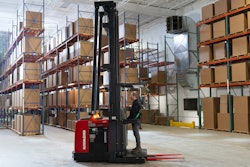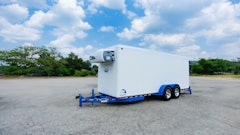
It’s easy to underestimate the transformational impact refrigeration has had on modern life. The American success story remains the invention of the modern cold chain. Research illustrates how this remarkable technology has enabled companies to preserve, transport, and make affordable a wide variety of foods.
But refrigeration is not just an engineering marvel—it’s also highly political. The Global Cold Chain Alliance (GCCA) sees every day the intense scrutiny the cold chain industry faces from policymakers and influencers. On one hand, the construction and operation of the cold chain is rightly celebrated for its economic and social benefits. On the other, it’s criticized for the environmental footprint that comes with the energy and resources required to keep food cold.
The refrigerant dilemma
The choice of refrigerant gas to be used in the design and operation of cold storage facilities is one of the first and most consequential decisions to make in a design and build project. It is also a choice that is highly regulated. Right now, this issue is front and center, because the EPA is revisiting decisions made during the Biden era about how best to regulate refrigerants.
Industrial refrigeration works by compressing and expanding a gas, which allows it to absorb heat within a closed space and reject it outside. Only certain gases do this efficiently, and the choice of refrigerant impacts everything—from the cold storage facility design and build, to how it’s run day to day.
Broadly, there are two categories: “natural” refrigerants such as carbon dioxide, ammonia, and propane; and “synthetic” refrigerants (commonly referred to as “F-gases”) produced through chemical processes.
F-gases are often highly efficient but carry heavy global warming potential (GWP) if released. Natural refrigerants have little or no direct warming effect but bring other challenges such as flammability or toxicity that must be carefully managed.
Global rules, local impact
Since the 1990s, efforts to limit high-GWP gases have played out on the global stage. Treaties like the Montreal Protocol and its successor, the Kigali Amendment, aim to phase down F-gases worldwide. GCCA recently represented the cold chain industry at a high-level meeting on Kigali implementation in Bangkok, Thailand.
This work is important because these global commitments have translated directly into U.S. regulations. Successive administrations have limited the availability of F-gases and banned new equipment using refrigerants above certain GWP thresholds. In 2024, the EPA introduced the Technology Transition Rule (TTR), which bans the sale of certain types of refrigeration equipment.
Under the TTR, equipment categories are assigned maximum GWP limits. Industrial-scale cold storage was classified alongside domestic refrigerators, with a cap of either 150 or 300 GWP, depending on the amount of gas used in the system. In contrast, other industrial refrigeration processes were given a more workable limit of 700, with a more extended compliance period. The result? A regulatory double standard that limits cold store facility design-build options, and disadvantages cold chain operators.
Pushing for fairness
In response, a coalition of refrigeration system manufacturers and cold storage stakeholders petitioned the EPA for reconsideration. GCCA aligns cold storage with other industrial users to create a fairer playing field. This reconsideration would allow some businesses to continue investing in modern high-efficiency F-Gas systems (built to minimize leaks and managed to reclaim and recycle refrigerant gases) in their cold storage construction and refurbishment projects.
At the same time, the industry continues to invest in natural refrigerant systems. Ammonia and CO2 systems are already the go-to technologies for most large-scale cold storage facilities, and there’s constant innovation in cold store design-build based around these technologies as well as improvements in the efficiency of natural refrigerant systems.
These systems are also very safe, both in plant design and because of the long experience of cold storage operators in managing and maintaining them. It is therefore frustrating that regulatory burdens and prejudices remain. In some cases, GCCA members face difficulties with poorly informed local officials being resistant to granting necessary permissions to construct facilities using natural refrigerants. Well-run facilities that meet the highest safety standards deserve proportionate oversight—not excessive bureaucracy.
Building a smarter regulatory landscape
As the EPA reconsiders refrigerant policy, we have an opportunity to reset the regulatory balance. Cold storage operators must have the flexibility to choose the cold store designs and refrigerant systems that best fit their needs — the right solution for the right system at the right time. Achieving the most efficient and sustainable cold chain requires balancing multiple priorities, and no one understands that better than the businesses that keep America’s food supply moving.
Smart regulation and industry collaboration are essential for our collective success.


















